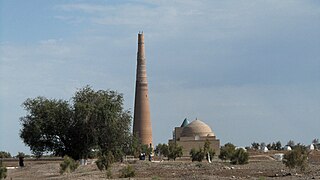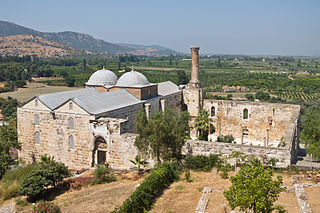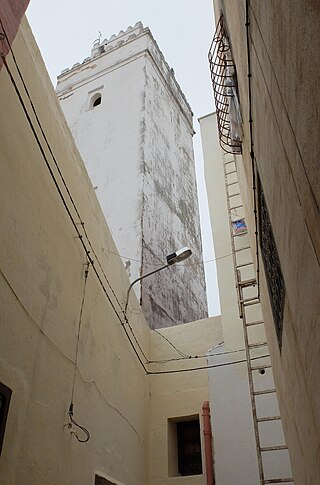Related Research Articles

Daşoguz Region is one of the regions of Turkmenistan. It is in the north of the country, bordering Uzbekistan. The area of the province is 73,430 square kilometers, and the total population is 1,550,354. The capital is Daşoguz.

The İsa Bey Mosque, constructed in 1374–75, is one of the oldest and most impressive works of architectural art remaining from the Anatolian beyliks. The mosque is situated on the outskirts of the Ayasluğ Hills at Selçuk, İzmir.

Iranian architecture or Persian architecture is the architecture of Iran and parts of the rest of West Asia, the Caucasus and Central Asia. Its history dates back to at least 5,000 BC with characteristic examples distributed over a vast area from Turkey and Iraq to Uzbekistan and Tajikistan, and from the Caucasus to Zanzibar. Persian buildings vary greatly in scale and function, from vernacular architecture to monumental complexes. In addition to historic gates, palaces, and mosques, the rapid growth of cities such as the capital Tehran has brought about a wave of demolition and new construction.

The Great Mosque of Samarra is a mosque from the 9th century CE located in Samarra, Iraq. The mosque was commissioned in 848 and completed in 851 by the Abbasid caliph Al-Mutawakkil who reigned from 847 until 861. At the time of construction, it was the world's largest mosque. It is known for its 52 metres (171 ft) high minaret encircled by a spiral ramp. The mosque is located within the 15,058-hectare (37,210-acre) Samarra Archaeological City UNESCO World Heritage Site, listed in 2007.

Hassan Tower or Tour Hassan (Arabic: صومعة حسان; is the minaret of an incomplete mosque in Rabat, Morocco. It was commissioned by Abu Yusuf Yaqub al-Mansur, the third caliph of the Almohad Caliphate, near the end of the 12th century. The tower was intended to be the largest minaret in the world, and the mosque, if completed, would have been the largest in the western Muslim world. When al-Mansur died in 1199, construction on the mosque stopped. The minaret was left standing at a height of 44 meters. The rest of the mosque was also left incomplete, with only the beginnings of several walls and 348 columns being constructed. The tower, along with the remains of the mosque and the modern Mausoleum of Mohammed V, forms an important historical and tourist complex in Rabat.

The Jāmeh Mosque of Isfahān or Jāme' Mosque of Isfahān, also known as the Atiq Mosque and the Friday Mosque of Isfahān, is a historic congregational mosque (Jāmeh) of Isfahan, Iran. The mosque is the result of continual construction, reconstruction, additions and renovations on the site from around 771 to the end of the 20th century. The Grand Bazaar of Isfahan can be found towards the southwest wing of the mosque. It has been a UNESCO World Heritage Site since 2012. It is one of the largest and most important monuments of Islamic architecture in Iran.

The Great Mosque of Taza is the most important religious building in the historic medina of Taza, Morocco. Founded in the 12th century by the Almohad caliph Abd al-Mu'min, it is the oldest surviving example of Almohad architecture. It was expanded by the Marinids in the late 13th century and renovated by the 'Alawi sultan al-Rashid in the 17th century.

Kerki is a city in and capital of Kerki District, Lebap Province, Turkmenistan. It was formerly known as Zamm and, between 1999 and 2017, as Atamyrat.

The Bou Inania Madrasa or Bu 'Inaniya Madrasa is a madrasa in Fes, Morocco, built in 1350–55 CE by Abu Inan Faris. It is the only madrasa in Morocco which also functioned as a congregational mosque. It is widely acknowledged as a high point of Marinid architecture and of historic Moroccan architecture generally.

The Great Mosque of Herat or "Jami Masjid of Herat", is a mosque in the city of Herat, in the Herat Province of north-western Afghanistan. It was built by the Ghurids, under the rule of Sultan Ghiyath al-Din Muhammad Ghori, who laid its foundation in 1200 CE. Later, it was extended several times as Herat changed rulers down the centuries from the Kartids, Timurids, Mughals and then the Uzbeks, all of whom supported the mosque. The fundamental structure of the mosque from the Ghurid period has been preserved, but parts have been added and modified. The Friday mosque in Herat was given its present appearance during the 20th century.

The Tarikhaneh Mosque, is a historic monument located on the southern limit of the present day city of Damghan, Iran.

The Saparmyrat Hajji is a mosque in Gökdepe, Turkmenistan. Commissioned in memory of the defenders of Gökdepe Fortress, it was built between 1994 and 1995, during the presidency of President Saparmyrat Nyýazow. The mosque—with its blue dome and four minarets—is a prominent landmark in Gökdepe.
Devkesen is an archaeological site in the Dashoguz region of northern Turkmenistan, 62 km west of Koneurgench.

The Great Mosque of Sfax was the most important mosque in the old city of Sfax, Tunisia. It was initially built towards the mid-9th century under the rule of the Aghlabid dynasty, a vassal state of the Abbasid Caliphate. The mosque was the urban and religious heart of the city and it underwent several major modifications in later periods. Architecturally, it is notable for its minaret and its unusually decorated eastern façade.
Gozli Ata is one of the remotest shrines of Turkmenistan, devoted to the eponymous saint.
Makhtumkala or Magtymgala is a riverside village in Turkmenistan.
Gerkez is a village in the Balkan Region of Turkmenistan along both sides of Sumbar, about 20 km west of Magtymguly. It is believed to be the birthplace of Magtymguly Pyragy.
Ismamut Ata is a mausoleum in the Khwarazm oasis of Turkmenistan. A cluster of religious structures, it stands amidst a graveyard and was once considered to be among the most prominent shrines in Turkestan.
Bagyr is a former village that has been annexed by the city of Ashgabat, the capital of Turkmenistan. It is presently a neighborhood of the capital city. Bagyr features archeological sites.
Murche is an abandoned village in the Ahal Region of Turkmenistan. The site is famed for the Mausoleum of Zengi Baba.
References
- 1 2 3 Dehistan / Mishrian - UNESCO World Heritage Centre
- 1 2 3 4 5 6 7 8 9 10 11 Brummell, Paul (2005). Turkmenistan. Bradt Travel Guides. p. 153. ISBN 978-1-84162-144-9.
- ↑ Brummell, Paul (2005). Turkmenistan. Bradt Travel Guides. p. 154. ISBN 978-1-84162-144-9.
- ↑ Gye, David; Hillenbrand, Robert (2001). "Mausolea at Merv and Dehistan". Iran. 39: 53–54. ISSN 0578-6967.